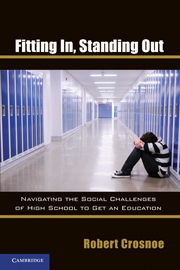Book contents
- Frontmatter
- Contents
- Acknowledgments
- PART I HIGH SCHOOLS AS CONTEXTS OF DEVELOPMENT
- PART II A CASE STUDY OF SOCIAL AND ACADEMIC EXPERIENCES IN HIGH SCHOOL
- PART III HELPING TEENAGERS NAVIGATE HIGH SCHOOL
- 9 Solutions within Schools
- 10 Looking to Parents and Other Adults
- 11 In Search of Theory and Action
- Works Cited
- Index
10 - Looking to Parents and Other Adults
Published online by Cambridge University Press: 05 June 2012
- Frontmatter
- Contents
- Acknowledgments
- PART I HIGH SCHOOLS AS CONTEXTS OF DEVELOPMENT
- PART II A CASE STUDY OF SOCIAL AND ACADEMIC EXPERIENCES IN HIGH SCHOOL
- PART III HELPING TEENAGERS NAVIGATE HIGH SCHOOL
- 9 Solutions within Schools
- 10 Looking to Parents and Other Adults
- 11 In Search of Theory and Action
- Works Cited
- Index
Summary
Despite how much time teenagers spend in high school and how important their school peers are on a daily basis, parents still loom large during the high school years and retain a great deal of power to intervene in their teenagers' lives, especially during times of crisis (Smetana, 2008; Steinberg, 2001; Steinberg & Morris, 2000; Eccles, 1994). Moreover, they retain primary roles as managers of teenagers' journeys through contemporary high school curricula, which, according to Epstein (2005), is precisely why one of the major sections of No Child Left Behind concerns parental involvement in education. Similarly, recall that the Lamar teenagers highlighted the role of nonparental mentors in their lives and explicitly linked such mentors to their understanding of resilience in the face of social problems at high school.
Yet, as I mentioned when discussing the policy dilemma in the last chapter, parenting is not a common, accepted, or easy focus of policy intervention for reasons that are political, cultural, legal, ethnical, and practical, although this is less true for nonfamilial mentoring (Granger, 2008; Spencer, 2006). As a result, my motivation is not just to view the not-fitting-in pathway through the lens of educational policy and intervention but also to discuss this pathway in terms of what parents and other adults with teenagers in high school need to understand and what they can do.
- Type
- Chapter
- Information
- Fitting In, Standing OutNavigating the Social Challenges of High School to Get an Education, pp. 230 - 240Publisher: Cambridge University PressPrint publication year: 2011



